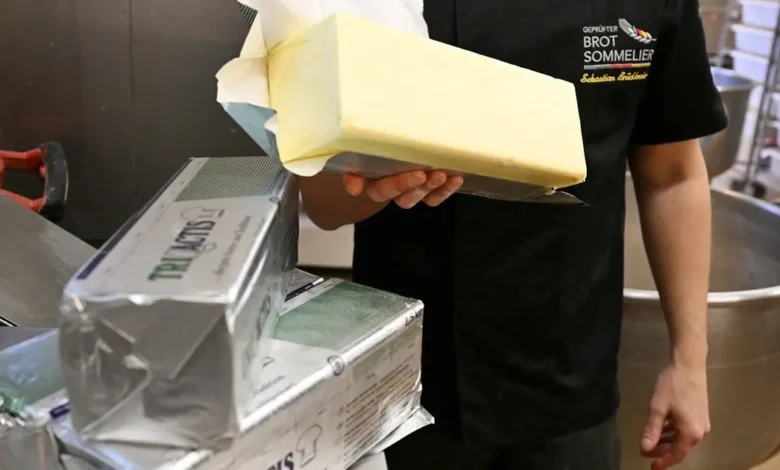Butter’s global price surge hits croissants and kitchens alike

At the Mamiche bakeries in the 9th and 10th arrondissements of Paris, their famous pains au chocolat and croissants depend on an essential but increasingly scarce ingredient — butter.
The bakery’s regular supplier can no longer provide a steady flow of French beurre de tourage, a type of flat butter used to make the pastries. Mamiche has gone searching elsewhere to ensure the steady flow of sweet treats from its ovens, but it’s coming with a cost.
Butter prices in most of the world are lingering near record highs, with little end in sight to the surge. It’s the result of a complex interplay of factors — challenges faced by dairy farmers from France to New Zealand, changes in Asian consumers’ appetites that’s spurring global demand, and commercial decisions by milk processors defending their bottom line.
The end result is more cost pressure on consumers’ favorite foods.
“When we have to change supplier, we can really see the difference” said Robin Orsoni, commercial operator for Mamiche. Other providers are charging prices 25 percent to 30 percent higher but Mamiche has to absorb the cost because “we want to make our customers happy, we need the butter.”
Around 70 percent of the butter exported around the world comes from two places — Europe and New Zealand. Each began 2025 with historically low stockpiles, and this supply tightness has caused prices to spike to a record, according to the Food and Agriculture Organization.
The roots of the squeeze can be traced back to 2022, when the price of milk in Europe peaked as inflation and fuel costs hit farmers hard, pushing dairy processors to look at the best way to maximize profits.
Butter is made by removing cream from raw milk and churning it. Once the process is complete, you are left with butter and buttermilk, the latter of which “has some industrial uses, but those are relatively limited,” said Monika Tothova, an economist at the FAO. It’s used for some cooking, to make other dairy products, and for livestock feed.
In contrast, “if you make cheese, you process the entire volume of milk,” said Tothova. Even the by-product from cheese-making, called whey, is in high demand from commercial food makers for flavoring and nutrition, or gym enthusiasts to bulk out the protein in their diets.
European Union dairy processors have making more and more cheese. As a result, the bloc’s butter production has steadily declined and is expected to hit an eight-year low this season, according to estimates from the US Department of Agriculture.
Milk production itself is also becoming more challenging. In Europe, farmers’ herd sizes are shrinking due to financial pressures, and they now face added risks to their cows from bluetongue virus, said Jose Saiz, a dairy market analyst at price reporting agency Expana. Lumpy skin disease, which can curb an infected cows’ milk yields, is also making its way into Italy and France.
Just as butter has fallen out of favor with dairy processors, consumers are developing a stronger taste for it, particularly in Asia.
Global consumption of butter is expected to grow 2.7 percent in 2025, outpacing production, according to the USDA. In China demand has already grown by 6 percent in just one year. Usage in Taiwan between 2024 and 2025 rose 4 percent, while in India, the world’s largest consumer, it is up 3 percent.
Hong Kong’s French bakery chain, Bakehouse, has been tapping into Asian consumers changing tastes. Its annual butter use is currently about 180 tons, an increase of 96 tons from the prior year after they opened two new stores, in addition to another 180 tons of cream, according to co-founder Gregoire Michaud. The firm only buys from well established suppliers — New Zealand has a top-tier reputation but China isn’t good enough yet, he said.
In New Zealand, which is a major dairy exporter and produces about 2.5 percent of global milk supply, butter production has yet to return to pre-pandemic levels, fluctuating around 500,000 tons a year since 2020.
As in Paris, supply scarcity and high butter prices have forced Hong Kong’s Bakehouse to cycle through three different providers in just a short period – from Australia, to New Zealand and then Belgium. Now they’re potentially looking for a fourth.
Western consumers are also eating more butter, which for years was shunned for being unhealthy, as they look to cut ultra-processed foods out of their diets.
Purchases of pure block butter in the UK have grown, said Susie Stannard, lead dairy analyst at the UK Agriculture and Horticulture Development Board. “Consumers who can afford it will still buy butter,” she said, but they aren’t immune from price pressures.
At the newly opened Morchella restaurant in London’s Clerkenwell district, the brown butter and bread that was so popular at its sister eatery, Perilla in Newington Green, has been replaced with olive oil.
Before the recent price hikes “you’d put a lot of butter into the pan to base that piece of fish and meat,” said Ben Marks, who heads up the kitchens at Perilla. “Now you’ve just got be much cleverer.”
Relief for consumers isn’t expected to come any time soon. Butter prices are also affected by the global conflicts, supply chain disruptions and tariff wars that have roiled every other commodity.
Amid this “very hot market,” Hong Kong’s Bakehouse is now prioritizing butter from closer providers to avoid a loss of supply, said Michaud.
Orsoni said Mamiche will absorb the higher cost of butter to keep French staples affordable for its customers, but Perilla’s Marks said it’s “inevitable” that diners will face higher prices.
The heat wave seen in Europe in recent weeks could also exacerbate the situation. High temperatures can reduce yields from diary cows, while also pushing up demand for other products that compete with butter for the fatty cream taken off the top of milk.
Tennis fans reaching for cream to accompany their strawberries as they watch Wimbledon, or workers cooling down with an ice cream in city plazas, “can only hold butter prices up,” said Stannard.










